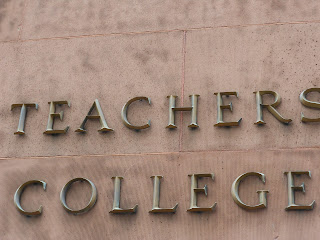
The World Trade site is right across from Trinity Church. We had the privilege of seeing the Freedom Tower http://www.renewnyc.com/plan_des_dev/wtc_site/new_design_plans/freedom_tower/default.asp as it is being constructed. This is another historic event in New York City. The rebuilding of the site symbolizes the resolve of democracy and the courage of it's citizens.
We continued to Trinity Church at Wall and Broadway.The tower of this church is a high point in Manhattan and the church is done in Gothic Revival style by the architect Richard Upjohn. The church doors were modeled after the famous bronze doors by Lorenzo Ghiberti at the baptistry in Firenze, Italy (BB, p. 65). They illustrate stories from the Bible including the Angel Gabriel announcing to Mary that she was with child. They are extraordinary and done in relief. In the graveyard at Trinity Church are old tombstones that mark the burial sites of people who died as far back as 1681. A statue of Robert Fulton who was important for the steam engine is also at the graveyard as are the tombs of Alexander Hamilton and other historical figures.
Federal Hall is where Congress met after the revolution and George Washington was sworn in as President (BB, p 69) http://www.nps.gov/feha/index.htm There are always current exhibits here. A collection of outstanding watercolors and other medium paintings of the US Coast Guard in action are on display. They are a tribute to the work that the US Coast Guard does to protect our lands.
Descending further down into the tip of Manhattan we enter Battery Park which was named for a row of cannons that defended the original fort. There is a large brass sphere which came from the plaza at the World Trade Center. The artist was Fritz Koenig and it originally symbolized "world peace through trade". After being damaged from debris during 911 it was reconstructed at Battery Park as a memorial to those who died (BB, p. 47). Passing Castle Clinton where tickets for the ferry to Ellis Island and The Statue of Liberty are bought, we enter the most beautiful area of the harbor. The site was originally a fort built to protect American ships from British attack before the War of 1812.
A treat is in store as we turn north along the beautiful esplanade which has become a river walk. This is a most scenic place as we ambulate on a picturesque walkway along the Hudson River. The city has changed.It is more beautiful now. Along the way we have a wide view of the harbor. The Statue of Liberty is in full view as are Ellis Island and the New Jersey skyline. Clean wooden benches built into the concrete and surrounded by flower beds beckon those in need of repose.It is a delight to ascend to Chelsea along this
route.

Eventually we reach the Highline which is a defunct elevated railway turned into an elevated park of unique magnitude. This is truly inspiring and we are lead uptown to the Poet's House at 10 River Terrace. There we are treated to a tour and find out about the wonderful world of poetry and writers. This is a non-profit poetry library and haven for writers. It offers a majestic view of the river and trees with a window wall. There are thousands of volumes of poetry and anyone can have their work put on the shelves. Workshops and educational workshops are offered to children to help establish the place of poets in the minds of those who otherwise would not be appreciative of this literary art. It is a way of seeing the world via a unique form of communication and expression.
After stopping at "gentrified" Chelsea Market for lunch we head for our final destination, the crazy art galleries of Chelsea http://chelseamarket.com/ .
The first week of each month, the exhibits change. There is some zany and some profane art. It is all meant to provoke and challenge the viewer to ask a question. Here are two portrayals of figures seen through a window of bubbling water. This is visually intriguing.


















































